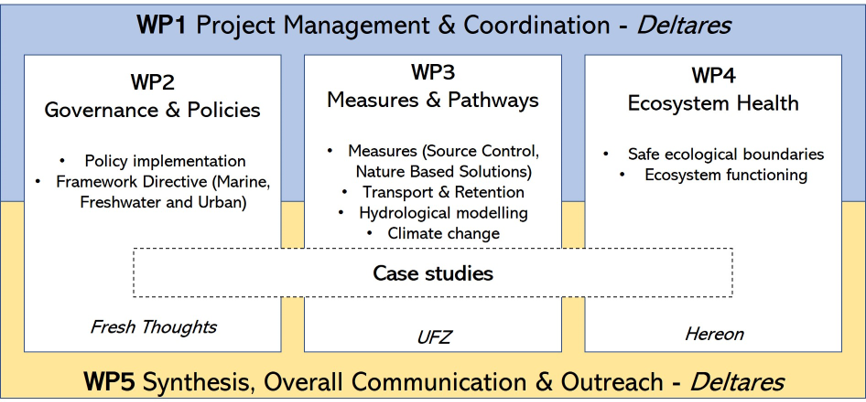Governance and policy
The goal of WP2 is to obtain improved support, with a set of guidelines to reach the policy vision of clean European seas by 2030.
Combating eutrophication in Europe has a long history, with substantial progress already being made. Nevertheless, a number of obstacles such as a lack of coherence between different policies and a lack of social acceptance of measures is still hampering the achievement of the required reductions in nutrient inputs. Hence, the objective of this WP is to analyze the policy and socio-economic dimension of nutrient management including major obstacles and showcasing of best practices on the implementation of sustainable and effective marine pollution reduction, prevention, mitigation and elimination measures (e.g. administrative, legal, financial, technical, social).
The overall objectives of WP2 are to:
- Investigate and evaluate the feasibility of existing strategies to reduce nutrient inputs to the Wadden Sea in the context of the ambition of the zero pollution strategy to reduce nutrient losses by 50%. This will be done along factors such as: i) legally binding character, ii) effort of implementation at all policy levels, iii) inclusion of freshwater protection objectives in other policy areas (such as the CAP), iv) implementation time and effectiveness of measures, v) costs and vi) acceptability by stakeholders.
- Assessment of effectiveness of current measures to reduce nutrient inputs. This analysis will be based on the River Basin Management Plans, MSFD Programme of Measures, relevant studies, stakeholder consultations and will be supplemented by expert judgement where needed. It will evaluate single measures as well as already existing nutrient reduction targets (e.g., load reduction targets, concentration management values 2.8 mg TN/l for Rhine and Elbe).
- Contribute to the overall synthesis of effectiveness and social acceptance of measures/reduction scenarios from the perspective of governance. The social acceptance of environmental measures is progressively becoming more important for policy and decision makers worldwide. Thus, studying social acceptance (socio-political acceptance, community acceptance, and market) and barriers (social, economic and cultural) are key factors for the implementation and the success of reducing nutrient pollution.
The work will result in improved support, with a set of guidelines to reach the policy vision of clean European seas by 2030.
Measures and pathways
The overarching goal of WP3 is to connect safe ecological boundaries in receiving waters with nutrient load reduction measures in the contributing catchments.
The overarching goal of WP3 is to connect safe ecological boundaries in receiving waters with nutrient load reduction measures in the contributing catchments. More specifically, this work package will propose scenarios of relevant measures to reduce nutrient inputs to surface waters and the Wadden Sea in and evaluate their effectiveness under different climate change scenarios. The work package will use a novel process-based modeling approach for nutrient transport and retention. The model will be set up for the three case studies to capture the current observed state of nutrient concentrations in surface waters and exports to the Wadden Sea and to implement the measures and climate scenarios. Results from the case studies will be transferred to other basins draining into the Wadden Sea using data-driven methods. WP3 is led by the UFZ with major contributions from UBA, Deltares and HEREON.
Ecosystem health
The goal of WP4 is to develop Safe Ecological Limits for each of the studied systems, based on local system functioning.
Eutrophication is one of the major challenges to ecosystem health both in aquatic and terrestrial systems. Progress has been made to combat eutrophication resulting in a 50% reduction in nutrient loads. Still, goals set in different political frameworks like OSPAR, the Water Framework Directive or the Marine Strategy Framework Directive have not been met yet. In NAPSEA, we will go beyond the more sectoral via as in the above mentioned political frameworks to develop a holistic view on ecosystem health regarding eutrophication within the entire land-river-sea continuum. In our study, the Wadden Sea is the ultimate receiver of the riverine nutrient loads. But eutrophication problems do occur upstream as for instance in the Elbe Estuary, where massive phytoplankton blooms from the Elbe river lead to oxygen deficiency. Therefore, four Case Studies are carried out that focus on different aspects of the land – river – sea continuum: The Hunze, the Elbe estuary, the Rhine and the Wadden Sea. For each of these systems, Safe Ecological Limits will be developed based on local system functioning. These
The objectives of WP4 are to:
- Review literature and available data on the currently used indicators, direct and indirect effects and nutrient targets as proposed by OSPAR, WFD and MSFD.
- Propose the safe ecological boundaries of N and P that ensure a good status of the continuum of inland coastal and marine water.
- Quantify the impact of nutrient reduction scenarios as developed in WP3 on estuarine, coastal, and marine waters on ecosystem health and services.
- Compare the effects of measures/reductions scenarios in terms of previously proposed targets with the newly proposed safe ecological limits.
- Contribute to the overall synthesis from the perspective of ecosystem health.


